I was listening to “For What It’s Worth”, early Buffalo Springfield, and it came to mind how much 60s rock music sucked. With few exceptions, music lacked bass, brass and had way too much circus organ keyboard. Lyrics were redundant, banal, and lacking in… substance. Fans were the product of overindulgent parents, free spirits moved by the winds of a gifted MasterCard and way too many Peter Pan adults over the age of 25. Sort of like a gathering at a Taylor Swift concert, or a socialist democrat event. Drove me to country music and soul… neither which exists much anymore. I mean is it really “Bad Wolves”, or should it be “Naughty Doggies”? So, for now, some Hall & Oats “You Make My Dreams Come True”… and maybe a little Running Man before my coworkers show up?
Seven bear loads for the 22 Hornet. Yeah, that’s not going to happen.
The Ruger Model 77/22 has been a good sport through all of the handload development. Trigger stayed crisp, action remained slick and the magazine fed without hesitation. The action is a major overkill for the Hornet round but, compact in size and light in weight, the extra strength doesn’t come with a penalty.
The 22 Hornet does not need to be pushed, cajoled or otherwise inveigled to perform at a higher level. That includes modification to the K wildcat version, significantly over pressure loading or buying a 32″ barrel. It is a moderate range cartridge intended for recreational target shooting and varmint and small game hunting. The high performance version of the 22 Hornet is called the 222 Remington or 223 Remington or any number of cartridges with significantly higher capacity than 14.5 grains of H2O and operating with a greater than 49,000 PSI SAAMI MAP.
If we arbitrarily and capriciously cap anticipated shooting distances at 150 yards… 200 yards on show off days, I do not know if the higher velocity of the 33 grain Speer or the better ballistic coefficient of the 55 Grain Remington bullet is the better choice. Actually, I do know, but if I spilled the beans at this juncture, there would be no point in me writing this piece, or you reading it for that matter. So let’s pretend I don’t know, let the suspense build, and we’ll all find out together. Remember to look surprised.
Time was spent rummaging through early reloading manuals, late 50s to early 60s in hopes of finding long lost data that could yield better than average accuracy, velocity and moderate average pressure. Instead, the manuals served as a reminder that, with few exceptions, most smokeless powder has been around since WW II. In this case, Lil’ Gun is the newest kid on the block.
Beware of the turtle

In some ways, the 22 Hornet requires a little finesse. Hornet bullets are stubby, regardless weight. A short ogive is necessary to seat a heavier weight bullet and still fall within the overall cartridge length specifications, but all have a modest ballistic coefficient. Above, bullets L-R 1,2,3, and 5 are examples of short ogive, or short nose bullets. Numbers 4, 6 and 7 are not actually intended for the 22 Hornet, but can be accommodated for the benefit of an improved ballistic coefficient.
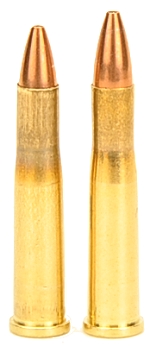
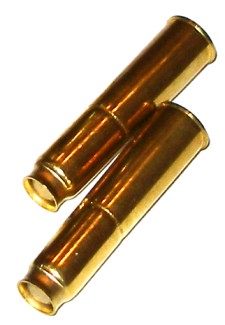
Leave it alone – Seated within maximum cartridge overall length, bullets not intended for the Hornet, labeled 4,6 and 7 above will seat with the transition from parallel shank surfaces to curvature of the nose below the case mouth (Above far left). I don’t care for it out of concern the edge of the case mouth will hang on to something when being fed and it looks sloppy. Beyond that, the recessed bullet presents no real issues. Ask anyone who has ever shot a 1895 Nagant Revolver and 7.62x38mmR ammo (Above).
Clean it up – Trim case back 0.080″ to 1.320″ and seat to a 1.720″ cartridge overall length. Same approach as using long ogive Hornady FTX bullets in cartridges like the 45-70 to keep cartridge maximum overall length in spec.
Load the cartridge to an overall length longer than specification. Checking the Ruger Model 77/22 with an overall length gauge for each extended nose bullet planned and checking rotary magazine clearance, it was found that a maximum length of 1.800″ would work cleanly. Subsequently, rounds were loaded to the length noted on the data table and charges adjusted to those lengths and resulting net case capacity.
Lee Precision out – Hornady Custom dies in
The Hornet has a long neck and case material is relatively thin. After seating a few bullets it became obvious that cases and bullets were having a hard time getting together on a common longitudinal axis with runout in excess of 0.008″. The problem appears to have been due to a combination of high neck tension and a lack of neck support in the seater. Not a general problem with Lee Precision dies as I use them with some routine. The Hornady seater surrounds the case neck and provided greater support and a concentric assembly. A significant consideration for accuracy.
Sorting brass is essential to accuracy as the capacity is small and the variances in case capacity are more than a little. A change in pressure and/or velocity will result in a measurable change in point of impact. Using a constant powder charge with a changing net case capacity within a population of handloads will open open up group sizes. So none of the brass conditions noted below are bad, they are just different.
| Case | Dry Weight Grains | Wet Weight Grains | Case Capacity H2O |
| Prvi New | 57.4 | 68.8 | 11.4 |
| Prvi FL Sized | 57.4 | 70.3 | 12.9 |
| Prvi Once Fired | 57.4 | 71.6 | 14.2 |
| Federal Plated New | 47.3 | 61.9 | 14.6 |
| Federal Plated FL Sized | 47.3 | 61.9 | 14.6 |
| Federal Plated Once Fired | 47.3 | 62.1 | 14.8 |
This is usually where the writer suggest neck versus full length sizing to maximize capacity, but I am not making that suggestion. Even the smallest capacity case had enough capacity to use full charges, with some requiring only mild compression as indicated on the data table that follows. It is only important to group them in broad strokes by capacity.
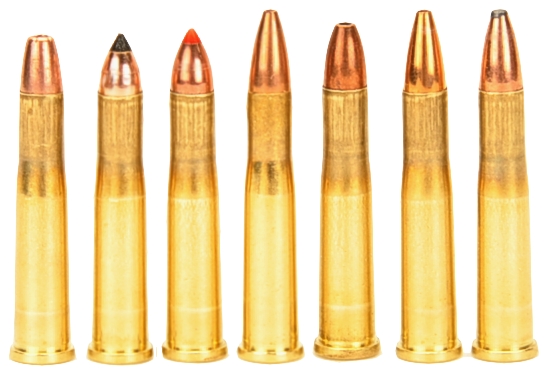
Assembled, they look a lot like the picture above. A secondary issue with the Lee Precision dies surfaced with the shorter rounds. I use a Redding T7 reloading press for most of my work. The combination of short Lee Precision dies and the thick turret head on the Redding press left me with barely enough adjustment range to properly seat bullets. Another issue cleaned up by changing to Hornady dies.
It isn’t always the rifle
So I cranked out several sets of each handload for some preliminary assessment and to collect some chronograph data and shot three shot groups with each… that looked like this examples…

Left to right, above – 1.6″, 1.3″, 2″. Beyond the large group sizes, the patterns of point of impact consistently placed 2 shots every close together and then put up a flyer. Worse, after the first two groups I pulled the barreled action from the stock and checked for weird pressure points, scoped the bore, re-tightened, the scope rings and shot the third group, the worst group. I did what any experienced enthusiast would do, put the rifle down, scratched my head and got a cup of coffee.
Just as one more element to isolate, I swapped the scope out and re-shot all of the groups, the worst and best above… let’s call it 1.0″, then 0.5″. It seemed a bit ironic that the Leupold scope was purchased nearly twenty years ago for, and heavily used on, an Ultra Lightweight 257 Weatherby, before being moved to a 338-378 Weatherby, before being moved to a 416 Weatherby, before being moved to a 500 Jeffery, and then it croaked on a 22 Hornet.
Handload Data… after sorting out
Warning: Bullet selections are specific, and loads are not valid with substitutions of different bullets of the same weight. Variations in bullet length will alter net case capacity, pressure and velocity. Primer selection is specific and primer types are not interchangeable. These are maximum loads in my firearms and may be excessive in others. All loads should be reduced by 5% as a starting point for development where cartridges have greater than 40 grains in capacity and 10% for cartridges with less than 40 grain capacity following safe handloading practices as represented in established mainstream reloading manuals. Presentation of these loads does not constitute a solicitation for their use, nor a recommendation.
| Cartridge: 22 Hornet (49,000 PSI MAP) |
|
| Firearm | Ruger 77/22 |
| Barrel Length | 24.0″ |
| Min – Max Case Length | 1.403″ +0.0″/-0.020″ |
| Min – Max Cartridge Overall Length | 1.660″ – 1.723″ |
| Primer | CCI BR4 |
| Bullet Diameter | 0.2245″ +0.000″/-0.0030″ |
| Reloading Dies | Lee Precision |
| Bullet Type | Bullet Weight Grains |
Net H2O Grains Capacity |
COL” | Powder Type | Powder Charge Grains |
Muzzle Velocity fps |
Muzzle Energy ft/lbs |
100 Yd 3 Shot Group” |
| Speer Hornet HP | 33 | 12.9 | 1.680 | AA 9 | 10.5 | 3102 |
705 | 1.1 |
| Speer Hornet HP | 33 | 12.9 | 1.680 | H110 | 13.0C | 3182 |
742 | 1.0 |
| Speer Hornet HP | 33 | 12.9 | 1.680 | Lil’ Gun | 13.5C | 3179 |
741 | 0.6 |
| Nosler Varmageddon | 35 | 12.3 | 1.705 | Alliant 2400 | 10.5 | 2966 |
684 | 0.9 |
| Nosler Varmageddon | 35 | 12.3 | 1.705 | H110 | 12.7C | 3164 |
778 | 1.0 |
| Nosler Varmageddon | 35 | 12.3 | 1.705 | Lil’ Gun | 13.5C | 3227 |
810 | 0.8 |
| Hornady V-Max | 35 | 12.4 | 1.715 | H110 | 12.8C | 3194 |
793 | 0.8 |
| Hornady V-Max | 35 | 12.4 | 1.715 | Lil’ Gun | 13.5C | 3238 |
815 | 0.5 |
| Hornady V-Max | 35 | 12.4 | 1.715 | RS Enforcer | 11.2 | 3031 |
714 | 0.9 |
| Sierra JHP | 40 | 12.0 | 1.800* |
H110 | 12.2 | 3036 |
819 | 0.4 |
| Sierra JHP | 40 | 12.0 | 1.800* | Lil’ Gun | 12.7C | 3096 |
852 | 0.9 |
| Sierra JHP | 40 | 12.0 | 1.800* | Win 296 | 12.2 | 3007 |
803 | 0.7 |
| Remington JHP | 45 | 12.5 | 1.720 | H110 | 12.2 | 2947 |
868 | 0.6 |
| Remington JHP | 45 | 12.5 | 1.720 | Lil’ Gun | 13.2C | 2981 |
888 | 1.0 |
| Remington JHP | 45 | 12.5 | 1.720 | Win 296 | 12.0 | 2903 |
842 | 0.5 |
| Berger FB | 50 | 10.6 | 1.800* |
H110 | 10.5 | 2730 |
828 | 0.6 |
| Berger FB | 50 | 10.6 | 1.800* | Lil’ Gun | 11.5 | 2761 |
847 | 0.5 |
| Berger FB | 50 | 10.6 | 1.800* | RS Enforcer | 10.5 | 2607 |
755 | 0.8 |
| Remington PSP | 55 | 10.7 | 1.800* |
H110 | 10.4 | 2582 |
814 | 0.9 |
| Remington PSP | 55 | 10.7 | 1.800* | Lil’ Gun | 10.2 | 2594 |
822 | 1.0 |
| Remington PSP | 55 | 10.7 | 1.800* | RS Enforcer | 9.5 | 2423 |
759 | 1.2 |
| *All exceed SAAMI Maximum cartridge length of 1.723″. All were verified to clear Ruger rotary magazine and rifling of subject firearm. | ||||||||
Last, lasting impressions
I don’t know about you, but I had fun. The Ruger Model 77/22 is a slick rifle, accurate and reliable. It doesn’t sound like a hollow drum when you tap on the stock, the finish is top notch both metal and laminated stock. Controls are smooth, bolt stroke is short and the rotary mag setup is handy. It worked for me for recreational target shooting, it was responsive to handloading, it was excellent at dispatching the local rodent population. If there is one think I could pick at, it would be nice if Ruger could upgrade the trigger to the quality they designed into their American rifle series. Pull is smooth, moderate in pull, but a tad on the long side. Another nice rifle, as we might anticipate, from Ruger.


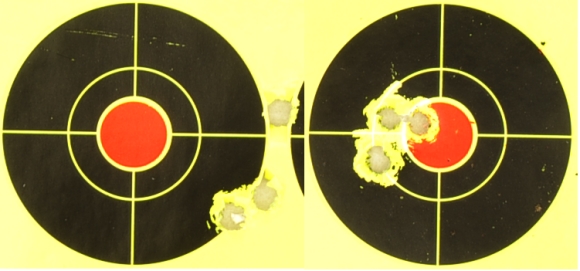
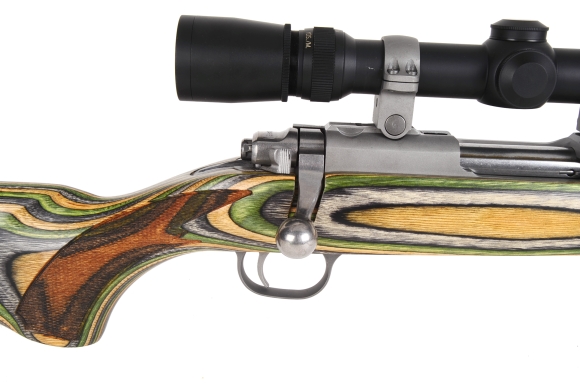
Email Notification